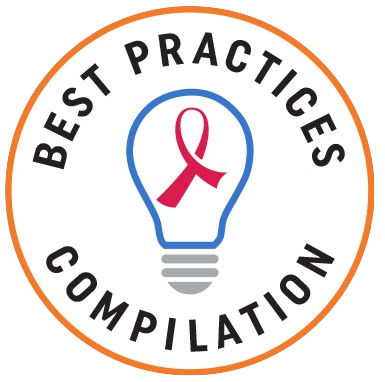The RWHAP Best Practices Compilation gathers and disseminates interventions that improve outcomes along the HIV care continuum. Explore the Compilation to find inspiration and new ideas for improving the care of people with HIV. Learn more about the Best Practices Compilation and submit your innovation today for possible inclusion.
Search Results
Displaying 1 - 7 of 7
Through the Test & Treat Rapid Access (TTRA) Program, clients with a new HIV diagnosis in Miami-Dade County can access ART, receive other services and counseling, start enrolling in RWHAP, and connect to HIV primary care during the initial visit. At Borinquen Health Care Center, one of the clinical sites participating in TTRA, 76% of clients were virally suppressed within three months of receiving a rapid ART start, and 95% were retained in care for 12 months.

Evidence-Informed Intervention
People with a new diagnosis of HIV; People with HIV who are not in care
HIV diagnosis; Linkage to HIV medical care; Prescription of antiretroviral therapy; Viral suppression
Clinical service delivery model
Miami-Dade County, FL
Through the Practice Transformation Project, the Native American Community Clinic and Midwest AIDS Education and Training Center developed strategies to increase testing and linkage to care within the American Indian/Alaska Native population, and for those who inject drugs and are experiencing homelessness. These ongoing efforts have increased HIV testing rates by 10 percentage points through harm reduction, community outreach, and culturally sensitive strategies.

Emerging Intervention
American Indian/Alaska Native people; People who inject drugs (PWID); People who are unstably housed
HIV diagnosis; Linkage to HIV medical care
Clinical service delivery model
Minneapolis, MN
JumpstART launched in 2016 as part of New York State’s Ending the Epidemic initiative, changing the service delivery model of eight sexual health clinics to include an initial prescription of ART after an HIV diagnosis and prior to linkage to the community provider. Between November 2016 and September 2018, 60% of JumpstART clients received ART on the same day as diagnosis. JumpstART clients were also more likely to reach viral suppression within three months compared to non-JumpstART clients.

Evidence-Informed Intervention
People with a new diagnosis of HIV
HIV diagnosis; Linkage to HIV medical care; Prescription of antiretroviral therapy; Viral suppression
Clinical service delivery model
New York City, NY
Viviendo Valiente aims to reduce ethnic disparities in HIV care and outcomes by providing culturally responsive services to the Latino/a community, specifically to people of Mexican descent. It is a multi-level intervention, featuring individual-, group-, and community-level activities, that links people to HIV care, offers HIV education and health literacy in group sessions, and promotes community-level testing for HIV and other sexually transmitted infections (STIs). Viviendo Valiente had positive impacts on HIV testing, retention in care, viral suppression, and client satisfaction.

Emerging Intervention
Hispanic/Latina(o/x) people
HIV diagnosis; Retention in HIV medical care; Viral suppression
Outreach and reengagement activities
Dallas, TX
Bienestar developed TransActivate to improve timely engagement and retention in HIV care among Latina transgender women. Linkage coordinators/peer navigators use a strengths-based approach to help clients reach their goals of entering and staying in medical care to ultimately reach viral suppression.

Emerging Intervention
Transgender women; Hispanic/Latina(o/x) people
HIV diagnosis; Linkage to HIV medical care; Retention in HIV medical care; Viral suppression
Support service delivery model
Los Angeles, CA
The Ruth M. Rothstein CORE Center launched Proyecto Promover to decrease HIV testing-related stigma, increase awareness of HIV status, and increase early linkage to and retention in care among Mexicanos with HIV. The program operates at the community level through social marketing, educational talks, networking, and testing. On the individual level, Proyecto Promover uses one-on-one conversations to identify and overcome barriers related to care engagement and retention. Evaluation showed promising rates of HIV testing, retention in care, and viral suppression.

Emerging Intervention
Hispanic/Latina(o/x) people
HIV diagnosis; Linkage to HIV medical care; Retention in HIV medical care; Viral suppression
Outreach and reengagement activities
Chicago, IL
The Oregon Health Authority awarded contracts to local public health authorities across the state to work with community partners to integrate early intervention services and outreach services, link people to HIV care, and provide support to help clients reach viral suppression. Quick linkage to care resulted in a median of 57 days to viral suppression for Early Intervention Services and Outreach clients in 2019.

Emerging Intervention
People with HIV who are not in care; People with undiagnosed HIV
HIV diagnosis; Linkage to HIV medical care
Support service delivery model
OR






